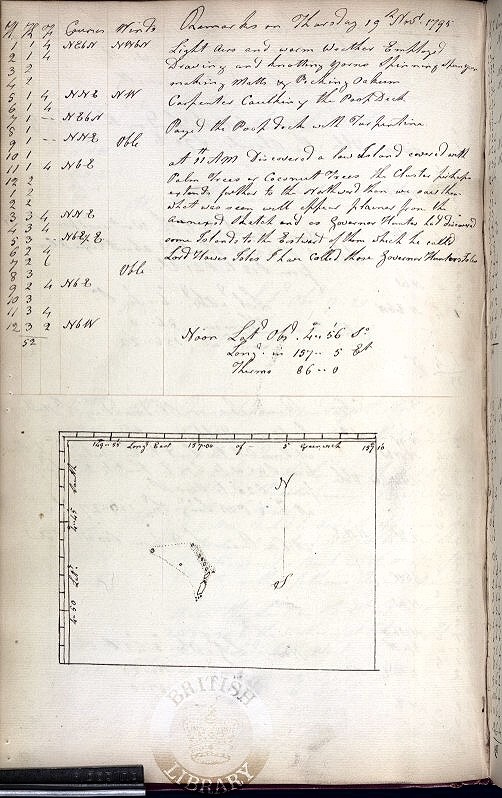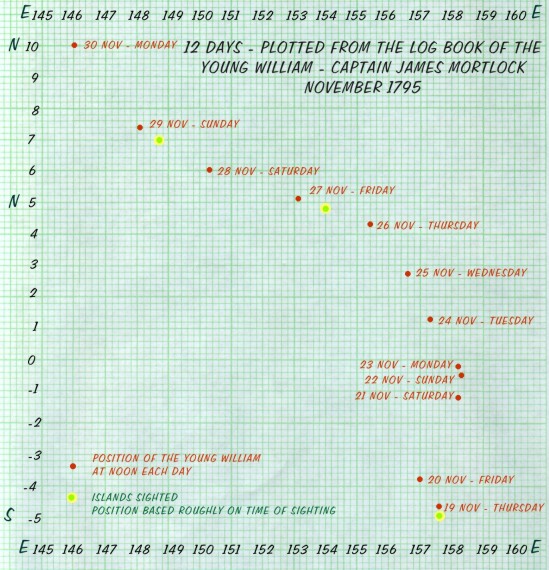Log Book of the Young William
James Mortlock (Ship's Master)
This page gives more details of the log book of the Young William as it relates to the discovery by of both sets of islands in the Pacific referred to on some maps as the Mortlock Islands. These Islands had no doubt been already discovered and inhabited by Pacific Islanders, and possibly also discovered by other non English speaking nations. This page refers to the first recorded discovery by users of the English language.
The Young William left London on 11th of September 1794, headed for Port Jackson in New South Wales (Australia) and then China. Port Jackson is today better known as Sydney harbour.
The log book records that in Port Jackson on Monday 26th October 1795, that Ralf Greeve and George Williamson were absent without leave. With permission of the Govenor the following people were shipped - William Burges, ?? Rudd, Charles Cornish and Edward Willen.
Prior to departing Port Jackson on the 28th of October 1795, the Young William was searched for convict stowaways. Three male convicts were found and based on information received, a female convict was found in the Chief Mate's chest. The Chief Mate was discharged at his own request.
The first set of Mortlock Islands, also known as the Takuu group were sighted on 19th November 1795.

The image above from the Log Book (L/MAR/B/427/A) has been reproduced by permission of the British Library.
It may not be copied without their written consent.
The page above records the fact that Govenor Hunter had discovered some islands to the East of this group, which he had named Lord Howe's Islands. James Mortlock named the group he discovered Govenor Hunter's Islands. However in the course of time it seems that they became known as Mortlock Islands.
Most pages of the log book mention little more than bare essentials like the ship's position at noon of each day, along with comments on the weather and temperature, which remained at 86°F for most of this part of the voyage. The only other comments apart from the sightings of Islands, refer to the crew being kept employed spinning yarns and caulking the decks. One assumes the yarns were being spun to caulk the decks with. Of course taken in it's other meaning, they could have been sitting around telling each other stories.
The second set of Mortlock Island's, the Micronesian group were sighted on the 27th November 1795.
I plotted the chart below from positions given in the log from 19th - 30th Nov.

The points plotted were taken from the daily 'noon' position as stated in the log. The position of sighted islands is approximate, since I am no navigator, so not all of the log readings are familiar to me. For example the set of islands spotted on 19th Nov were sighted at 11:00 am, one hour before the noon position reading. On the 27th land was spotted at day break. Assuming this is around 6:00 am, I have placed those islands roughly 3/4 of the distance between the noon reading on the 26th and the noon reading on the 27th.
By mid December 1795 the Young William had reached southern China, between Macao and Hong Kong. The page I have from this part of the voyage starts on 17th December, so I don't know if she stopped at Macao, though it is mentioned. On the 18th she moored between Lintin and the Boca Tigris. On the 19th she had entered the Boca Tigris. She passed the second bar on the 20th and moored at Whampoa ( a few miles down the pearl river from Canton ( Guangzhou )) on the 21st. By Christmas day 25th December, she was ready for sea again and the journey back to England.
The Young William arrived back in London on the 4th August 1796.
If you have additional information about the Young William or James Mortlock. Please let me know.